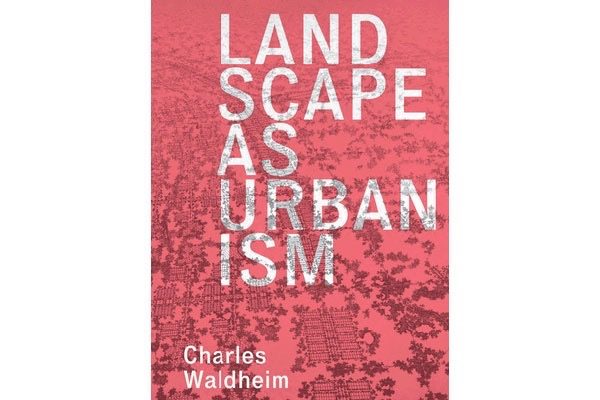
Author: Charles Waldheim (Princeton University Press, 2016)
It goes without saying that despite its contemporary meaning, practice of ŌĆśurbanismŌĆÖ is as old as the city, itself. And over the thousands of years of development, the intentions and ideas shaping the urban environment have changed countless times, adapting to constantly evolving social, technological, environmental and cultural circumstances. In light of the deep-seated associations between cities and built artifacts such as architecture and infrastructure, historically the urban world has often been conceptualized in opposition to the natural landscape within which it sits.
The rise of ecological thought and global environmental concerns over the past decades, however, has transformed our understanding of the city and its relationship to landscape. So much so that many are arguing for landscape is a model for the city and that urbanism must be understood and conceptualized through the lens of landscape. This is the foundation of landscape urbanismŌĆöa theory of urban planning, born in the late 1980s-early 1990s across RMIT University and the University of Pennsylvania.┬ĀCharles Waldheim, currently the John E. Irving Professor of Landscape Architecture at Harvard UniversityŌĆÖs Graduate School of Design and former dean at the University of Toronto, was a student at the University of Pennsylvania during formative years of landscape urbanism and has since authored and edited of several books on the subject, including this most recent Landscape as Urbanism: A General Theory.
Recently shortlisted for the 2017 National Urban Design Book Award organized by the United KingdomŌĆÖs Urban Design Group, Landscape as Urbanism brings together years of research and writing on landscape urbanism towards, as described in the title, ŌĆ£a general theory for thinking about the city through landscapeŌĆØ and ŌĆ£rethinking the urbanŌĆØ.┬Ā As such, he puts for the landscape urbanism as ŌĆ£a new set of practicesŌĆØ critical to meaningfully engaging the challenges of our time.
This is no small feat. And in order to do so, Waldheim meticulously analyses and dissects urban design and planning practices over time, in relation to the perception of landscape and the evolving discipline of landscape architecture. He does this in the service of describing the roots and development of landscape urbanism discourse: an act that necessarily crosses paths with a variety of key urban planning/design figures, projects and ideas, from James CornerŌĆöwhose essay Terra Fluxus┬Āserved to anchor ideas critical to landscape urbanismŌĆöto Frank Lloyd Wright, Ludwig Hilberseimer to David Harvey, Rem Koolhass to Andrea Branzi to Bernard Tschumi to Michael Van Valkenburgh, Kenneth Frampton to West 8ŌĆ”..to name just a few.
Accessible written and peppered with related imagery, the bookŌĆÖs structure outlines the varied narrative that intersect to tell the story of landscape urbanism. An excellent introductionŌĆöFrom Figure to FieldŌĆöserves to clearly┬Ā define the ŌĆślandscape urbanismŌĆÖ expression and frame the larger content put forth in the book. It includes succinct summaries of the each of the nine chapters that followŌĆöClaiming Landscape as Urbanism, Autonomy, Indeterminacy, Self-Organization, Planning, Ecology, and the Emergence of Landscape, Post-Fordist Economies and Logistics Landscape, Urban Crisis and the Origins of Landscape, Urban Order and Structural Change, Agrarian Urbanism and the Aerial Subject, Aerial Representation and Airport Landscape, Claiming Landscape as Architecture, and Conclusion: From Landscape to EcologyŌĆöoffering readers a strong buttress to the book, as a whole.
Generously, Princeton University Press offers free pdf copies of the Table of Contents and this superb Introduction through their website. And in light of this, one would do well to download and read the latter, in order to get a comprehensive breakdown of the content of the book and WaldheimŌĆÖs articulate writing style.
Suffice to say, as one of the leading voices and purveyors of landscape urbanism, their is no better guide to the subject than Charles Waldheim. As such, Landscape as Urbanism: A General Theory stands in a league of its own, not only as a summary of WaldheimŌĆÖs work on the subject to-date, but also as a convincing and powerful argument for the relevance of landscape as a lens through which the contemporary city must be engaged.
***
For more information on Landscape as Urbanism: A General Theory, visit the Princeton University Press website. And be sure to download and read Introduction: From Figure to Field.
**
Erick Villagomez┬Āis one of the Editor-in-Chief┬Āat Spacing Vancouver. He is also an educator, independent researcher and designer with personal and professional interests in the urban landscapes. His private practice ŌĆō┬ĀMetis Design|Build┬ĀŌĆō is an innovative practice dedicated to a collaborative and ecologically responsible approach to the design and construction of places. You can see more of his artwork on his┬ĀVisual Thoughts Tumblr┬Āand follow him on his instagram account: @e_vill1.




